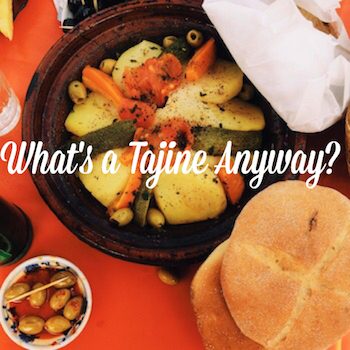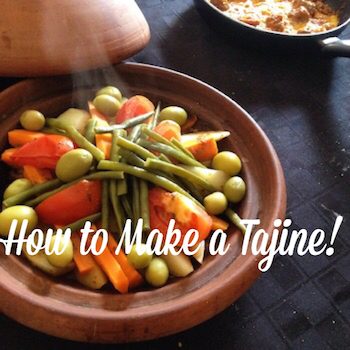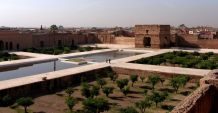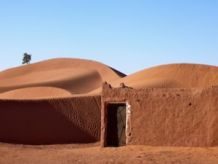
After couscous, the first food travelers encounter in Morocco is the tajine. Admittedly there is a lot of confusion about what a tajine is or isn’t. There are two definitions of the word tajine. First, it is a slow-cooked stew. Second, it is the name of the vessel that the food is cooked in; a tajine is cooked inside a tajine vessel.
Tajine – the Cooking Vessel
Tajine – the cooking vessel – is a very simple pot that has been used for centuries. Variations of the pot are used in cultures around the world. The base of the vessel is clay, and the techniques used to create a tajine and other clay pots have been found as far back as the Neolithic (better known as the stone age) period. Over time techniques and materials were refined but the basis has remained the same. There are two types of tajines in Morocco, a glazed and unglazed version. You’ll also find many hand-painted tajines for sale. These aren’t used to cook in but can be used to serve.
How to Make a Tajine!
One misconception people have is that there is a single type of tajine, when in fact there are dozens. As much as tajine is a dish, it more accurately defines a cooking method.
There are 4 “must have” components to make a tajine.
The tajine pot
Spices
Vegetables, fruit, and/or meat
Water

The simplest tajine is made with vegetables. The nature of cooking in Morocco is to use whatever is in the season so this is the biggest factor in deciding what will be in the tajine. Vegetables are layered from the hardest at the bottom to the softest at the top. They are placed in a circular pattern and layered into a cone shape. Spices are added either as a marinade or dry. Tomatoes are often used as an additional source of liquid and flavor. A little bit of water is also needed to keep things from burning and create steam.
When everything is ready the top is put on and the tajine placed over a heat source. Either charcoal or a low gas flame is the most common. A good cook knows when to crack open the lid to check. The food inside cooks by the build-up of heat and slight pressure so each time the lid is removed the heat is released. This is why it’s important to keep it covered as long as possible.
Along with the cooking, method tajines are also known for their complexity of flavor. A mixture of sweet and savory components set them apart from other dishes. Some of the most common tajines served include chicken tajine with preserved lemon and olives, beef or lamb tajine with prunes and fried almonds, vegetable tajine with in-season produce, fish tajine with peppers and tomatoes, and meatball tajine with tomato sauce and poached eggs. Seasonally specialties like lamb with peas and artichokes or beef with eggplants are a special treat. If you’re able to try a unique tajine either in a home or restaurant, do it! Chances are you might not find it again during your visit.
Tajine – the cooking vessel – is a very simple pot that has been used for centuries.
It’s very typical to see chef’s and restaurants outside Morocco serve tajine with couscous on the side or underneath tajine. This is never done in Morocco. Tajine and couscous are two different meals, cooked different ways and eaten different ways. Don’t expect your tajine to come with couscous on the side. Instead, you’ll use bread to eat the dish. Moroccans use pieces of fresh flatbread to scoop up the dish. Eat in the area directly in front of you if sharing a dish with others – the common way of eating. For those who have an allergy to gluten or prefer not to eat carbs don’t be surprised if there are no forks in sight, but do feel free to ask for one.
For more information about How to Make a Tajine or A Taste of Morocco Food Tour
Amanda Mouttaki is a food and travel writer and blogger, with expertise on Moroccan culinary traditions and food culture. Her passion is uncovering the stories behind traditional cultures and food around the world. She lives in Marrakech, Morocco with her family.





